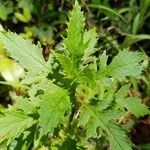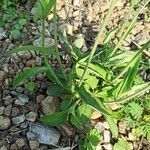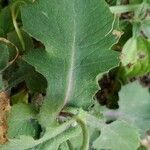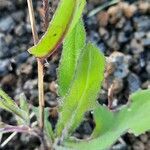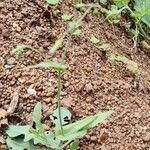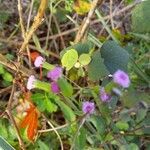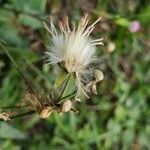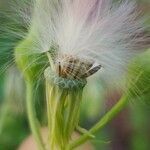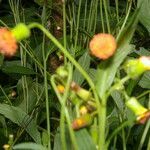Herbs, annual; root vertical. Stems erect or ascending, gray-green, 25-40 cm tall, rather curved, usually branching from base, glabrous or sparsely pilose. Leaves thick, lower leaves crowded, abaxially dark green, often becoming purple, lyrate-pinnatilobed, 5-10 × 2.5-6.5 cm; terminal lobe large, broadly ovate-triangular, margin irregularly dentate, apex obtuse or subrounded; lateral lobes usually paired, oblong or oblong-lanceolate, both surfaces crisped-hairy, margin shallowly and bluntly dentate, apex obtuse or acute. Median stem leaves lax, sessile, smaller, ovate-lanceolate or oblong-lanceolate, basally hastately semiamplexicaul, margin entire or irregularly denticulate, apically acute; upper leaves few, linear. Capitula pendulous before anthesis, erect later, usually 2-5, in terminal lax corymbs; peduncles 2.5-5 cm, slender, not bracteate. Involucres cylindric, 6-12 × 1.5-4 mm; phyllaries 8 or 9, yellow-green, oblong-linear or linear, nearly equaling florets, glabrous, margin narrowly scarious, apically acuminate. Florets pink or purplish; corolla ca. 9 mm, with slender tube and dilated limb, deeply 5-lobed. Achenes cylindric, 3-4 mm, puberulent between ribs, 5-ribbed. Pappus of capillary-like bristles, snow white, ca. 8 mm. Fl. Jul-Oct. 2n = 10, 20.
Annuals to c. 0.5 m high; stems and leaves sparsely hairy, becoming glabrous. Leaves to c. 8 cm long, with l:w ratio c. 2–4, undivided or sometimes lobate to pinnatisect, sometimes petiole-like with lamina much broader distally; margin dentate; upper-stem leaves becoming lanceolate, auriculate. Inflorescences of 1–several capitula; mature peduncle to c. 80 mm long, ecalyculate; involucre 7–12 mm long, 2–4 mm diam.; bracts c. 6–8; stereome flat, with 3–5 resin ducts, with a few coarse hairs or glabrous; receptacular pits not or very slightly raised. Florets c. 30; corolla 6–10 mm long, slightly shorter than, equal to, or exceeding involucre by up to 2.5 mm; base c. 0.3 mm diam.; limb 1/3–2/5 of total length, narrowly obconical, pink; style branch appendage purple. Achenes narrowly obloid, 2.2–3.8 mm long, with 5 broad ±flat ribs, brown or straw-coloured, with scattered hairs in grooves. Pappus 5–8 mm long; bristles minutely scabrid-barbellate.
Plants 20–80 cm, glabrous or ± villous. Stems 1, erect or somewhat lax, simple or branched. Leaves mostly in proximal 1 / 2 ; usually petiolate; blades ovate to obovate or oblanceolate, mostly 5–12 × 1.5–4.5 cm (distal smaller, bractlike), margins often deeply lobed to lyrate-pinnatifid. Involucres urceolate to campanulate, 9–12 mm, relatively slender, lengths mostly 3–4 times diams. Phyllaries usually 8. Florets 15–30[–40], surpassing involucres by 0–1(–2) mm; corollas usually lavender, pinkish, or purplish, rarely reddish, lobes 0.5–0.7[–1.5] mm; style appendages 0–0.1 mm. 2n = 10.
An erect or sometimes straggling, smooth or slightly hairy plant. It is about 10 to 40 cm high. The stems are slender. The leaves are somewhat fleshy and the lower ones lobed. The leaves are often clustered towards the base of the plant. They are 5 to 10 cm long and 1-5 cm wide. The flowering heads are purple. They are in loose branched arrangements. The flower stalk is 3-7 cm long. There are about 30 flowers.
